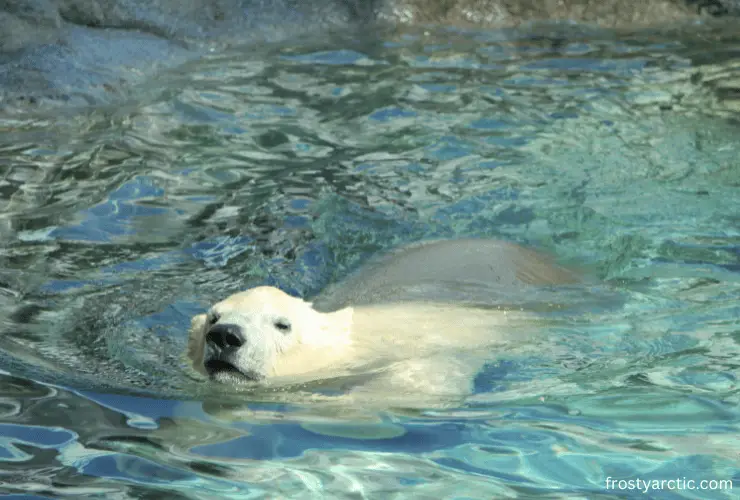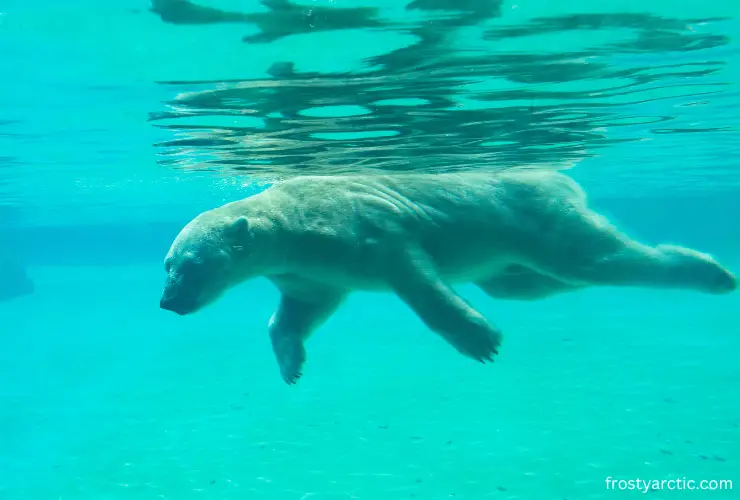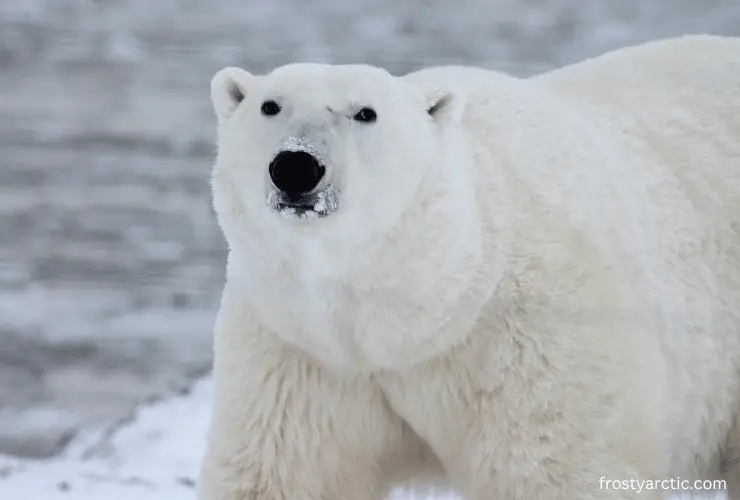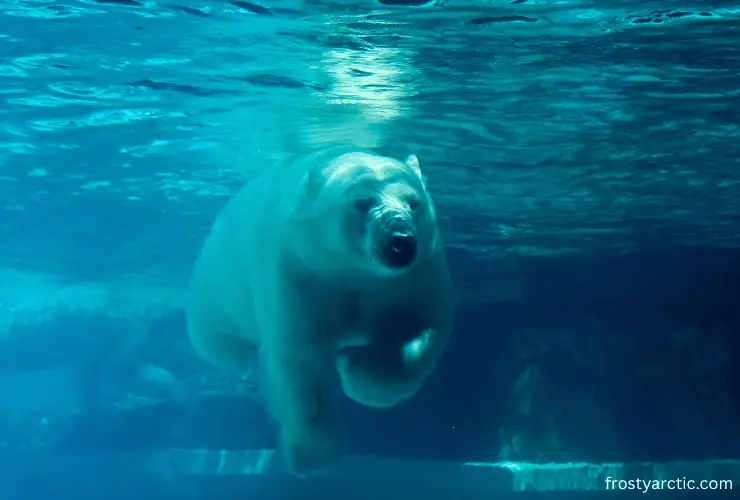As one of the largest land carnivores on the planet, polar bears can hold their breath for approximately two minutes. It’s a brief span when they take a plunge or dive. However, their typical underwater dive lasts only a minute.
Just like all mammals, polar bears also have the universal ability to adapt to the environment and modify their physiological traits and attributes. Interestingly, while polar bears are capable divers, their dives are generally shorter than those of other marine and aquatic mammals.
Before a dive, polar bears fill their flexible lungs with a rich supply of oxygen. This helps them store more oxygen in their lungs and bloodstream, which is crucial for sustaining them during the dive.
How Do Polar Bears Breathe? Let’s Discuss the Breathing Mechanism
As magnificent apex predators of the Arctic, Polar Bears possess a unique breathing mechanism ideally suited for their dual terrestrial and aquatic lifestyles. While there are similarities with human respiration, polar bears exhibit intriguing adaptations that distinguish their breathing patterns and requirements.
In a day, polar bears take approximately 30 to 40 breaths per minute on land, much like us humans. They have nostrils through which they inhale and exhale. Likewise, their respiratory tract pathway is similar to ours.
However, polar bears showcase unique elastic lungs that contract as they dive, preventing complications during deep descents.
These lungs, combined with the remarkable oxygen-storing protein myoglobin in their muscles, help sustain them during underwater pursuits.
When submerged, their breath-holding ability stands out, allowing them to stay underwater for up to two minutes—briefly compared to marine mammals like dolphins. The comparison with humans is intriguing, as polar bears breathe at a faster pace per minute, reflecting a heightened metabolic rate in their cold environment.

The question may arise: Why don’t polar bears face difficulties breathing in cold air, unlike humans, who experience unpleasant effects? This is because the incoming air has a significantly colder temperature than the body temperature and contains relatively less moisture than the internal membrane, consequently drying out our respiratory system.
In the case of Polar Bears, their muzzle (nose) is relatively much longer. This extended length allows the incoming air to stay in the nasal cavity for a greater period, consequently reducing its temperature.
The lining of mucous and turbinates (specialized bony structures in front of the nose) moisturize the incoming air and lower its temperature. Through the course of evolution, bears adopted these characteristics to aid them in surviving the harsh Antarctic environments.
Although their lung capacity is not precisely known, it is estimated that a polar bear can hold almost 30 liters of air volume inside its lungs, nearly six times the lung capacity of a human. This large lung capacity allows the polar bears to hold their breath for up to two minutes underwater, which is essential for their hunting behavior.
While polar bears do not possess gills like fish, their adaptations enable them to thrive in their icy aquatic habitat. The polar bear’s respiratory system enables them to transition seamlessly between land and water, which is crucial for both hunting seals on ice and swimming in search of prey.
Their ability to plunge into Arctic waters with such skill is a testament to their evolutionary success.
Why Can’t Polar Bears Breathe Underwater?

Polar bears, while expert swimmers, cannot breathe underwater like fish or some other sea creatures. Unlike fish, which have gills to extract oxygen from water, polar bears are mammals and rely on their lungs to breathe air.
Gills are special organs found in fish and some aquatic animals that help them extract oxygen from water. These tiny structures act as filters, allowing water to flow over them and enabling the exchange of oxygen and carbon dioxide. This allows fish to “breathe” underwater by extracting oxygen from the dissolved oxygen in the water.
Polar bears, on the other hand, have lungs just like humans. Their respiratory system is designed to breathe in oxygen from the air. When polar bears dive into the water to catch prey or swim, they hold their breath and utilize the oxygen stored in their lungs.
They are excellent divers, capable of holding their breath for several minutes and diving to significant depths. However, they can’t extract oxygen from water like fish can through their gills.
Polar bears are adapted to their icy Arctic environment in various ways. As previously mentioned, their breathing process is well-optimized for their lifestyle.
Additionally, polar bears are skilled at conserving energy during long swims, often gliding gracefully through the water to save precious energy reserves.
How Long Can Polar Bears Hold Their Breath on The Ground and Underwater?

Polar bears are remarkable swimmers, yet their ability to hold their breath varies both on land and underwater. On land, polar bears can hold their breath for a few minutes, typically around 2 to 3 minutes. This is because their breathing rate slows down when they are not active, aiding in energy conservation.
However, when it comes to underwater swimming, polar bears can showcase their impressive diving skills. They can hold their breath for much longer underwater, often staying submerged for about 1 to 2 minutes and occasionally up to 3 minutes.
It’s interesting to note that young polar bears have shorter breath-holding abilities compared to adult bears. As they gain more experience and practice, they become more skilled at managing their breath while swimming and hunting. Over time, they develop better breath control and adapt to the demands of their aquatic lifestyle.
Maximum recorded breath-holding time for a Polar Bear
In a research report, Ian Stirling (Associate Professor of the Department of Biological Sciences at the University of Alberta) revealed the following data:
The maximum recorded breath-holding time for a Polar Bear was found to be 3 minutes and 10 seconds, as observed by some scientists in the Norwegian archipelago of Svalbard. (Source)
However, the absolute maximum breath-holding time for Polar Bears is still unknown. It is possible that they can hold their breath for longer than this, but this has not yet been definitively proven.
Their success at holding their breath underwater is aided by their remarkable lung capacity. Polar bears have larger lungs compared to their body size, allowing them to take in more oxygen during each breath.
This is particularly advantageous during dives and hunts, as they can store more oxygen in their lungs to sustain them during their aquatic endeavors. When a polar bear dives into the water, it utilizes the oxygen stored in its lungs, and its heart rate slows down to conserve oxygen.
Moreover, polar bears are well adapted to the frigid Arctic waters. Their body structure and layer of blubber provide insulation, helping them conserve heat and energy while swimming. Their powerful front paws act as paddles, propelling them through the water with ease.
During a typical dive, a polar bear’s heart rate can drop from around 46 beats per minute (bpm) to as low as 27 bpm, further conserving oxygen. This impressive ability to slow down their metabolism helps them endure longer dives and increases their chances of successfully hunting prey like seals.
Seals are a favorite food source for Polar Bears. To hunt them, polar bears often use a technique called “still-hunting.” They approach a seal’s breathing hole in the ice and wait patiently for the seal to surface. This method requires careful timing and breath control. The bear’s ability to hold its breath for several minutes is crucial during this waiting game.
Can Polar Bears See Underwater?
Yes, Polar Bears can see clearly and vividly underwater. They possess a special adaptation called the nictitating membrane, which is a clear inner eyelid that protects their eyes and serves as a second lens when they are underwater. This membrane helps reduce glare and refraction (the bending of light in water), allowing the bears to see rather clearly underwater.
Polar bears also possess a layer of fat behind their eyes that helps protect them from the cold water. This layer of fat also helps refract light, which further improves the bears’ underwater vision.
Polar Bears Have Better Night Vision: Compared to Many Other Mammals
Compared to many other mammals, polar bears also possess another unique adaptation that helps them have better night vision. They possess a special layer called the tapetum lucidum, which is a reflective layer of tissue behind the retina. This layer reflects light back through the retina, helping the bear see better in low light conditions.
Although their underwater vision is clear and vivid, polar bears also compensate by relying heavily on their exceptional sense of smell. Underwater, they can detect scents carried by the currents, which aids them in locating seals and other prey.
Additionally, polar bears use their highly sensitive whiskers, known as vibrissae, to detect vibrations and movements in the water, aiding them in sensing the presence of prey and navigating.
Can Polar Bears Sleep Underwater?

Polar bears cannot sleep underwater. Unlike some aquatic animals like dolphins, which have the ability to sleep with one half of their brain at a time, allowing them to surface for air while still resting, polar bears do not have this adaptation. If a polar bear were to fall asleep underwater, it could drown because it needs to breathe air just like humans do.
Polar bears have specific places where they rest and sleep, mostly on land or sea ice. They create cozy spots called “day beds” or “snow beds” by digging shallow hollows in the snow or ice. These beds provide insulation from the cold and wind, helping them conserve body heat.
Polar bears also rest on the frozen sea ice, especially during their hunting expeditions. They might curl up or stretch out, depending on how cold it is and how they feel most comfortable.
While polar bears do not sleep underwater, they may rest on floating sea ice. This allows them to take short breaks during long swims between ice floes while hunting seals. They may even rest on ice floes near the breathing holes of seals, waiting patiently for their prey to surface.
Is There Any Bear That Can Breathe Underwater?
No bear, or any other mammal, for that matter, can breathe underwater. All mammals, including bears, have lungs for breathing air, not gills for extracting oxygen from water. Gills are specialized structures found in fish and some aquatic creatures that are designed to extract oxygen from water.
While it might seem interesting to imagine a creature with both gills and lungs, creating such a hybrid would be a complex biological challenge. Lungs and gills have evolved separately to suit the specific needs of different environments. Lungs are efficient for extracting oxygen from air, while gills are specialized for extracting oxygen from water.
Creating an animal with both functioning gills and lungs would likely involve intricate adaptations in the respiratory and circulatory systems. Additionally, maintaining two such complex systems could require a significant amount of energy, potentially outweighing any benefits gained from such a hybrid adaptation.
In the natural world, creatures tend to evolve traits that best suit their environments and ways of life. While bears are skilled swimmers, their reliance on lungs means they must come to surface to breathe, preventing them from true underwater breathing like fish.
Verdict
The breath-holding abilities of polar bears reflect their remarkable adaptations to their dual terrestrial and aquatic lifestyles. While their lung capacity and oxygen-storing proteins enable them to stay submerged for some minutes, their reliance on their lungs for air prevents them from breathing underwater like aquatic creatures.
Polar bears’ mastery of breath control, combined with their sensory adaptations and energy-efficient swimming techniques, allows them to navigate the icy waters of the Arctic with finesse. As apex predators, these remarkable bears have evolved a respiratory system that seamlessly transitions between land and water, highlighting their unique position within the natural world.
In this article, I discussed the respiratory capabilities of Polar Bears and related concepts. I hope this comprehensive exploration sheds light on the intricacies of how polar bears manage their breath, both on land and underwater. If you have any questions or comments, feel free to share them in the comment section below!



3 thoughts on “How Long Can Polar Bears Hold Their Breath?”